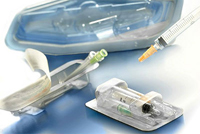Medical Plastics
Packaging Trends Keep Expanding
 In
terms of the future, experts say medical packaging will be dramatically
different by the end of the next decade. Medical device and pharmaceutical
packaging will become easier to use, less costly to produce and provide much
better protection in the future. In
terms of the future, experts say medical packaging will be dramatically
different by the end of the next decade. Medical device and pharmaceutical
packaging will become easier to use, less costly to produce and provide much
better protection in the future.
These significant changes in
medical packaging in the coming decade will strongly impact the materials used
in medical packaging. Many forces in alternative drug delivery methods, advances
in interactive medical packaging and possible future legislation to require drug
packaging to carry tactile (Braille) information are already laying the
groundwork for this transformation.
To start with, the
rapidly-changing healthcare industry is continually driving development of
alternative drug-delivery systems including oral film, nasal spray and
inhalation delivery. Such drug delivery systems significantly impact medical
packaging material requirements as the packaging function is shifted from a
passive to active one.
Factors driving these changes in
medical delivery methods are pharmaceutical companies’ needs to extend the
commercial life of patented drugs, the need by physicians to improve patient
treatment/compliance, and added benefits that accrue to patients by facilitating
drug delivery. Drugs delivered by these alternative technologies - especially
those that are biologic based - are typically sensitive to moisture, oxygen and
light and thus require high barrier packaging.
For example, pMDIs (pressurized
metered dose inhalers) provide diabetes patients with a convenient alternative
to the needle injection form of insulin. Aspira, a breath-actuated inhaler
commercialized by Medicom, includes an integrated dose-counter, which can record
up to 300 individual doses, important for people who have difficulties tracking
their medication and can help with patient compliance issues.
 In
the U.S., the Food and Drug Administ-ration (FDA) is encouraging that each
primary package produced should carry a radio frequency identification (RFID)
tag with a unique code. Tags activate packaging line operations, such as
labeling, provide data for pedigree records, and help track and trace product
through the supply chain to prevent counterfeiting and diversion. In
the U.S., the Food and Drug Administ-ration (FDA) is encouraging that each
primary package produced should carry a radio frequency identification (RFID)
tag with a unique code. Tags activate packaging line operations, such as
labeling, provide data for pedigree records, and help track and trace product
through the supply chain to prevent counterfeiting and diversion.
Medical packaging engineers
increasingly need to work with formulation chemists to understand the specifics
of the compounds they are packaging. A range of sorbents are increasingly used
to avert chemical and/or physical degradation from occurring in the
pharmaceutical package. These sorbents can be customized to eliminate oxygen
from the packaged environment while managing free moisture and maintaining a
specific equilibrium relative humidity, critically important to ensuring the
integrity of certain new drug compositions.
For formulations used in new
dry-powder inhaler systems a moisture-management system is needed to prevent the
drug product from becoming hydrated and the particles agglomerating, or
clustering together while also avoiding excessive drying that could promote
static charge of particles and compromise the performance of the device.
Building further, terminally
sterilized packaging harmonization is a technical market driver in medical
plastics packaging. The International Organization for Standardization (ISO) has
revised ISO11607 “Packaging for Terminally Sterilized Medical Devices,” to
harmonize it with the European Committee for Standardization (CEN) EN 868-1,
“Packaging Materials and Systems for Medical Devices Which Are to be
Sterilized.”
The revised ISO 11607 is divided
into two separate sections: “Part 1: Requirements for Materials, Sterile Barrier
Systems, and Packaging Systems,” and “Part 2: Validation Requirements for
Forming, Sealing, and Assembly Processes.” This latest revision takes into
consideration the changes and advances in both technology and regulations in the
medical device industry.
The Sterilization Packaging
Manufacturers Council (SPMC), a section of the Flexible Packaging Association in
the U.S., has condensed the complex requirements of the standard and associated
guidance document into a two-article series with the first part exploring two
critical areas: design inputs and the selection/evaluation of materials. Also
analyzed is the design of the sterile barrier system and associated protective
packaging, packaging process feasibility evaluation/optimization, and sterile
barrier system design feasibility.
The law requires
pharmaceutical/biotechnology manufacturers to provide serialized identification
on prescription drug products and to produce ePedigrees as part of electronic
supply chain records. Each organization handling the drug at each stage of the
supply chain must update the record. This ePedigree will track each drug at the
smallest item level with a unique serial number and must be in an electronic
format (e.g. RFID or variable bar codes) that is interoperable throughout the
supply chain.
( Ref:
http://exclusive.multibriefs.com/content/medical-plasticspackaging-trends-keep-expanding/engineering
)
|

